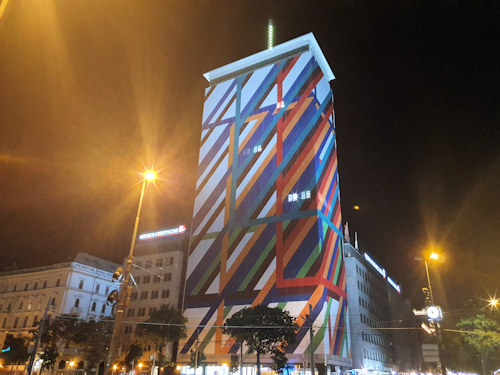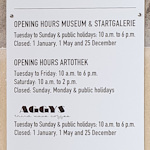
You don’t have to spend money to enjoy Austria’s capital. Here are my suggestions for free things to do and see in Vienna…
Make the most of your stay with my…
Exhibition tips for 2024

Concert tips for 2024

Free activities, sights, & experiences
Like any place full of tourist attractions, the city has plenty of ways to help you part with your money. But what can you do for free in Vienna?
Your options for sights and activities requiring no money include all the following:
- Art and architecture
- Churches and the cathedral
- Parks and palaces
- Woods, walks & rivers
- Composer and artist trails
- Free events and festivals
- Not free, but cheap
Before we begin, though, just a word about getting around.
Many central sights are within walking distance of each other. However, the public transport system here is remarkably cheap, so you might consider buying, for example, a Vienna City Card ( a network travel card designed for visitors) to save yourself a bit of time.
Architecture & art
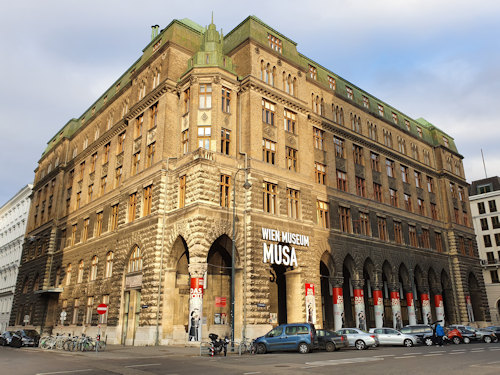
(The exhibition in the Startgalerie of the Wien Museum MUSA is free to enter)
Walk just about anywhere in Vienna and you’re bound to bump into an interesting building.
To simply soak up this historical cityscape, follow the detailed recommendations in the What can you do in a day? article and/or follow my tips for various self-guided walking tours.
For specific architectural eras, look for the location tips for Baroque, Biedermeier, Jugendstil and Historicism styles.
But what about free art?
Most of Vienna’s many art museums and exhibition venues require an entrance ticket, but a handful allow free entry.
The MQ
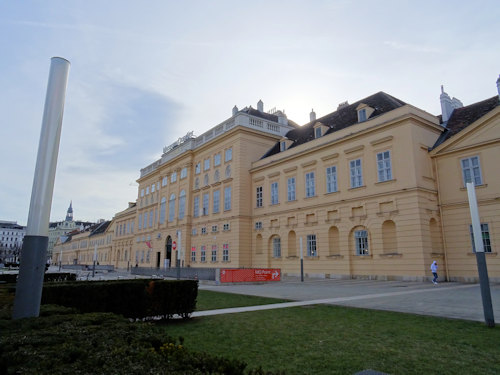
(The MQ main entrance)
The MuseumsQuartier (MQ) houses various museums and institutions as a sort of melting pot of contemporary art and culture. Open courtyards, bars and cafés invite you to wander through the complex.
You do need a ticket for most of the big exhibitions, but…
- The MQ’s Freiraum and Salon exhibition space usually hosts a couple of exhibitions each year. These are often (though not always) free.
- The MQ Art Box is a permanent glass-sided container in the main courtyard with an art installation inside that changes every two months or so.
- Around nine of the passageways between buildings and courtyards form what the MQ calls micromuseums, which means the thoroughfares have one or more distinctive features. A typical example might be a creative ceiling fresco.
- The MQ Libelle is an open space, art installation, and viewing platform on the roof of the Leopold Museum. Also free.
Other options
(The Ringturm with its exterior art)
Outside the MuseumsQuartier, try…
- The Wien Museum MUSA features contemporary Viennese art. While the main exhibition hall requires a ticket, the smaller Startgalerie room hosts solo exhibitions of up and coming artists, with free entry.
- A similar principle applies at the Bank Austria Kunstforum Wien. This prestigious venue charges for the main exhibition, but access to the smaller tresor exhibition space is normally free. (Note the Kunstforum closes between its main exhibitions.)
- The Theseus temple rises somewhat incongruously from the middle of the Volksgarten park.
The building actually owes its existence to the need for somewhere to show off a remarkable piece of art (Canova’s Theseus Group sculpture). Vienna’s Kunsthistorisches Museum group now uses the temple in the warmer months for an art installation by some renowned contemporary artist.
- The Ringturm insurance office building offers a few secret delights. One is the Architektur im Ringturm exhibition, which usually tackles some architectural theme from Central and Eastern Europe.
So you might find, for example, a look at the work of a famous architect or presentations of award-winning building projects.
- If you enjoy street art, then take a walk along the Donaukanal. This channel of the Danube river runs across the edge of Vienna’s old town. The embankment walls either side of the water burst with urban art. Some of it wonderful, some of it, ahem, less so.
- The KÖR Public Art Vienna programme deserves a special shout out. KÖR funds freely-accessible temporary and permanent public art installations (over 200 to date), which you find dotted throughout Vienna. The subway station near the university I sometimes teach at has one, for example.
Cathedral & churches
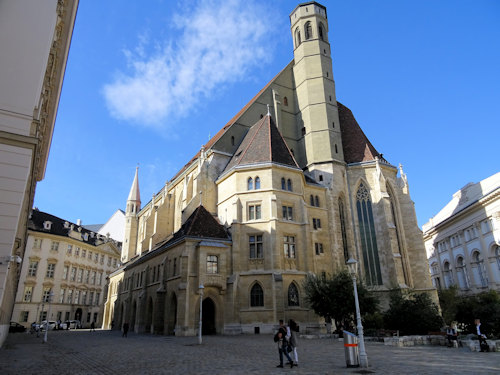
(The Minoritenkirche, which you might recognise from The Third Man)
Vienna’s landmark sight in the very centre is Stephansdom cathedral. You do need a ticket to look around most of the inside and to access the towers and other interesting bits of the building. But you can actually view some of this Gothic giant without paying.
The area immediately after you enter the main entrance and up part of the north side costs nothing to wander into and around.
The central area of town also has a number of lovely churches you can view for free. For example:
- The Peterskirche with its extraordinary baroque ornamentation
- The Minoritenkirche with its proud bell tower
- The Augustinerkirche with its striking Canova memorial
- The Annakirche, which rivals the Peterskirche for interior baroque glory
- The Michaelerkirche, which includes parts dating back to the 1200s
Parks & palaces
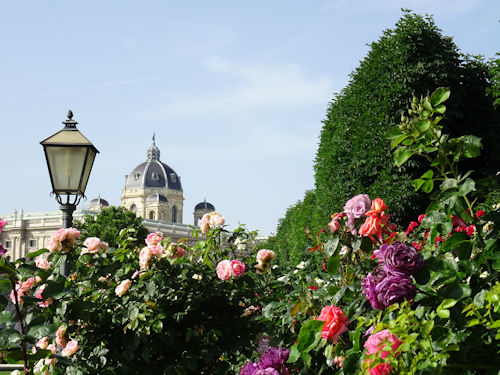
(The Rose Garden in the Volksgarten park)
Vienna is famously full of public city parks requiring no entrance fee. And some of them look rather delightful. Here some suggestions:
- Most people go to Schönbrunn to tour inside the 18th-century palace that housed various emperors and empresses (including Franz Joseph and the famous Sisi). But the huge landscaped gardens and wider park are free to visit, with the exception of a couple of small locations.
The park has such (free) delights as a Roman ruins (albeit fake), an obelisk, a rose garden, and a botanic garden. View the wonderful exterior architecture of the palace (obviously) but also see the giant Palm House, the Gloriette, and much more from outside at least.
- Belvedere consists of two 18th-century palaces at either end of a rising terrace with landscaped baroque gardens.
You need tickets to go inside the palaces, which feature excellent art exhibitions and provide a home for Klimt’s The Kiss. But the main gardens are free, as is the adjoining botanical garden run by the university of Vienna.
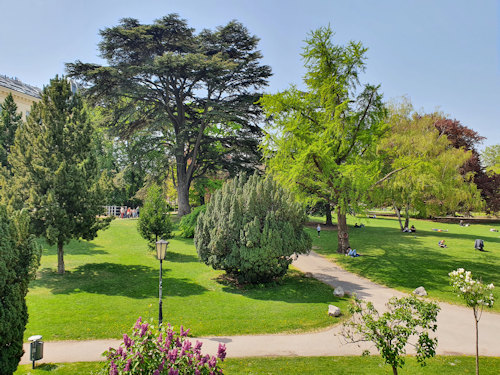
(The Burggarten park in the old town)
- The small Burggarten park sits behind the Neue Burg wing of the Hofburg place in Vienna’s centre and borders the Albertina art museum. The Burggarten itself is just a nice bit of green space but has one particular point in its favour: the famous Mozart monument.
- Talking Mozart…if you want to see where they buried him, then head out to the former cemetery at St.Marx. The location has a remarkable atmosphere with nature slowly conquering the gravestones.
- Staying on the composer theme, the Stadtpark (also very central) has its own famous monument: the golden Strauss statue that’s become one of the city’s most popular photo opportunities.
Other composers also have monuments here, including Schubert and Lehár. The park itself is rather fine, too, with the modest River Wien running through it (not to be confused with the Danube).
- A short walk up from the Burggarten, just off Heldenplatz square, is the Volksgarten park. This one becomes a true delight in late spring and early summer, thanks to the spectacular rose garden. Fans of Empress Elisabeth (Sisi) should enjoy the large memorial to her.
- The huge Prater has a park area with waterways, meadows, woodland walks, cycle paths and other recreational facilities. Notable for the amusement complex at one end (home to the Giant Ferris wheel, for example) and the long Hauptallee boulevard that runs right down the centre (a favourite with runners).
Woods, walks & rivers
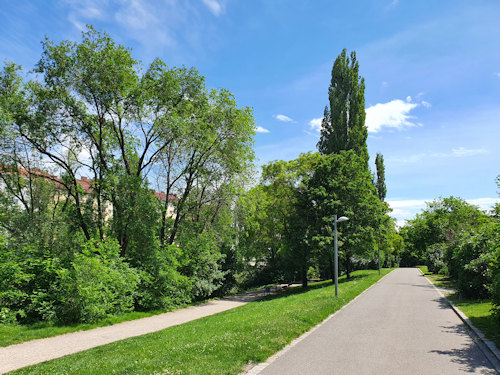
(Out along the banks of the Donaukanal)
Parks aren’t the only green places to stretch your legs in Vienna. We have a lot of woods and waterways, for example, including a rather large river you might have heard of.
If that tickles your interest, browse Vienna’s information on official hiking paths around the city, particularly those in the western woods and hills. Other free options include:
- Riverside walks: walking and cycle routes run along Vienna’s waterways, most notably:
- The length of the Danube and down the island that splits the river where it passes through Vienna
- The Donaukanal Danube channel meanders close to the city centre with dedicated bicycle paths and footpaths
- The Alte Donau is a lake, but a rather big one with plenty of lakeside footpaths
- Lainzer Tiergarten is a large managed wilderness on the edge of the city, notable for its wildlife (I’ve encountered wild boar there, which is a story for another day) but also for the Hermesvilla, a large summer retreat built for Empress Elisabeth in the 1880s.
- The city runs a surprisingly lovely set of large gardens at Hirchstetten that include various bonus features, such as a mini-zoo, palmhouse, themed horticultural areas, a maze, and more. Still a well-kept secret, possibly because the location is a little off the traditional tourist track.
Composer & artist trails
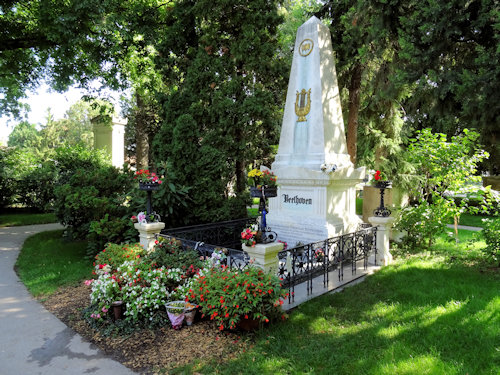
(Beethoven’s grave in the public Zentralfriedhof cemetery)
If you happen to be an admirer of Vienna’s famous musicians, artists and/or architects, then many biographical landmarks can be admired from the outside.
I mentioned Mozart’s grave earlier. And you’ll find those of Beethoven, Johann Strauss II, Schubert, and many others at the Zentralfriedhof cemetery.
For detailed maps and lists of relevant biographical addresses for all the above names, plus Klimt, Schiele, Mahler, Empress Elisabeth, Hundertwasser, Haydn, Brahms, Liszt, Bruckner, Lehár, and Otto Wagner, see here.
Free events & festivals
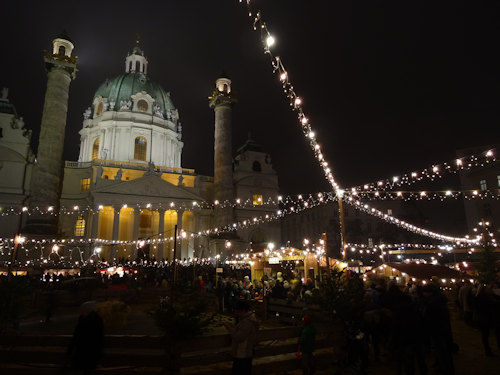
(Karlsplatz Christmas market)
I have a whole page dealing with annual events and festivals in Vienna; many of these are completely free. And the monthly suggestions for activities linked to from that page often include experiences that won’t burden your credit card.
Some particular highlights to watch out for:
You can enjoy them without buying anything. Just soak up the atmosphere, breathe in the scents, revel in the lights and historical surrounds, and browse the stands with all their crafts, gourmet foods and other items not normally sold in your average department store.
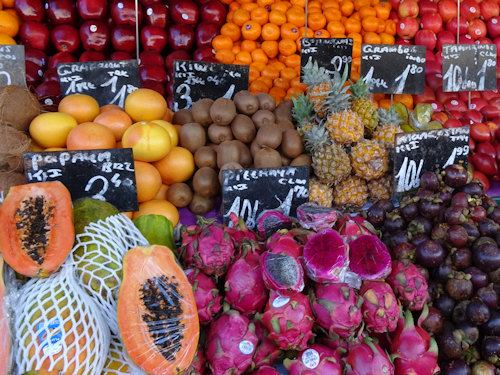
(The year-round Naschmarkt food market offers its own sensory experience)
- Europe’s biggest free open-air music festival takes place in Vienna (usually in June): the Donauinselfest draws in something like 2.5 million visitors
- Two notable open-air film festivals in summer are free.
- The Rathaus Film Festival takes place on the square in front of city hall and features concerts from different genres (but with a focus on classical and opera)
- The Frameout open air film festival at the MQ offers a mixture of films
- Free concerts also dot the Vienna event calendar, for example…
- The Summer Night Concert by the Wiener Philharmoniker in the gardens of Schönbrunn
- The Fest der Freude concert (always May 8) by the Wiener Symphoniker on Heldenplatz square
- The Popfest (late July) and Gürtel Nightwalk (typically late August) events, which offer free concerts where the music is more 2024 than 1824
Not free, but cheap
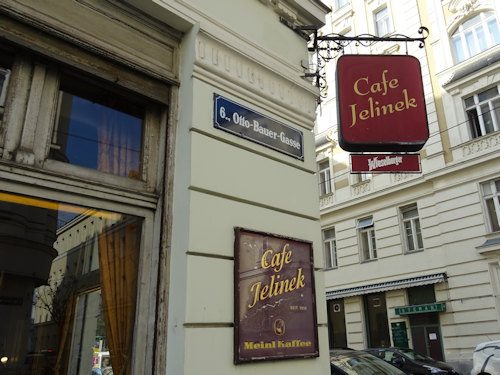
(One of Vienna’s many lovely coffee houses)
This is an article about what to do for free in Vienna, but two opportunities allow you to enjoy some special Viennese experiences without spending much money at all.
So, for what it’s worth:
- Vienna’s traditional cafés form part of the cultural fabric of the city. And you should be able to sit in them for as long as you like with your first order of coffee (with cake optional but recommended). Nobody will hassle you to move on. It’s all part of the coffee house tradition.
- Standing space tickets to the State Opera House cost as little as €13 on the day (even less if you book in advance, though that’s a little more complicated).
After all that you should have given your finances a bit of a break. Leaving plenty over for some traditional Viennese food. Enjoy.
